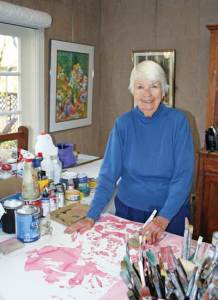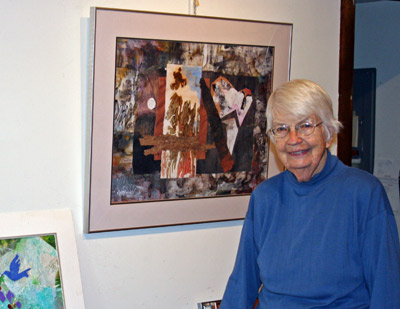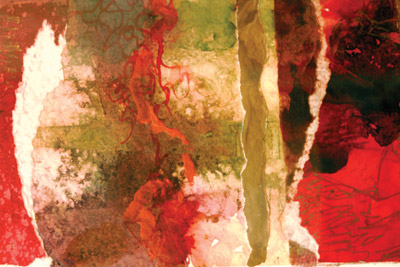Longtime Jacksonville resident and artist Elaine Witteveen passed away peacefully in her sleep at her home on Saturday, March 21, 2015 at the age of 98.
Elaine was born and raised in Chicago and attended the Art Institute of Chicago. In 1946, she relocated to Jacksonville where she worked as an artist from her home studio on North Oregon Street for over six decades. In that time, she explored various art media and styles. She was a founder of the Eugene Art Center and was appointed by Oregon governor Bob Straub to serve on the Oregon Art Commission board. In 1979, she formed the Jacksonville Artists’ Workshop, a group of 45 artists who held an annual show for decades at the US Hotel Ballroom each summer.
With many paintings reflective of Jacksonville, much of her work was done in “realistic” style until Elaine began using collage to create abstract work. Speaking about her work, she said, “After many years of creating realistic work, I moved to abstract and collage imagery. I look back at my work and I love having been able to create all these images, even if the occasional viewer does ask, ‘What is it supposed to be’?”
In February, 2015, the Rogue Gallery & Art Center in Medford held a special multi-week show, “Wings: Celebrating the Life and Work of Elaine A. Witteveen.” The show featured Elaine’s work with nearly 40 paintings she produced in the last twenty years. Some of the paintings depicted the landscape of Jacksonville with a majority of the work being Elaine’s more recent renditions of abstract art. Prior to the opening of the show, Rogue Gallery Executive Director Kim Hearon was quoted as saying, “Elaine is a local icon of the arts. It is a privilege to be able to have an exhibit that recognizes her talent and lifelong career as an artist.”
Memorial service arrangements are pending at this time… we will update this story once details are available.
Below is a 2007 Jacksonville Review article about Elaine Witteveen by Carolyn Kingsnorth.
Getting Better
At 90, Elaine Witteveen, the doyenne of Southern Oregon artists, is not getting older, she’s getting better. “At least I hope you can say that about my painting,” she responds.
 Of course, Elaine may have a hard time topping what she has already achieved. In addition to all the accolades she has received for her art, she was a founding member of the Maude Kerns Art Center in Eugene, served three years as a board member of the Oregon Arts Commission, and pioneered the Rogue Valley Artists Workshop.
Of course, Elaine may have a hard time topping what she has already achieved. In addition to all the accolades she has received for her art, she was a founding member of the Maude Kerns Art Center in Eugene, served three years as a board member of the Oregon Arts Commission, and pioneered the Rogue Valley Artists Workshop.
She has drawn and painted as long as she can remember.
“I grew up in Chicago. I went to the Chicago Art Institute from the time I was a little kid. They had Saturday classes for children. Sometimes we took field trips to the Field Museum of Natural History. They had all the animals in dioramas, and we drew them. We also had life-sized statues of Greek art and we drew them. That’s how I learned to do figure drawing, and that’s how I learned to love Greek art.”
She won a scholarship to the Art Institute while in high school. After high school, she studied philosophy at the University of Chicago and attended the American Academy of Art at night. That was when she met her late husband, John Witteveen.
“Johnny had a little photography store about two blocks from where I lived. He used to print my photographs. I would go in and we would chat. He worked for the Illinois Central and ran his business at night. It got so that he would be on the train platform when he knew I was coming home from school,” Elaine recalls.
“He loved music and would invite me over to hear his records. That’s how we got to know each other. I also got to know a lot more about music,” she laughs.
“I thought he was so mature and knowledgeable. It just sort of grew into marriage. Then he went in the military—World War II. He was training at Fort Sam Houston in San Antonio, and I went down there to marry him before he shipped over to England.”
Elaine considered joining the WACS, but with both John and a brother in the European Theater of Operations, her family discouraged her. Instead, she finished her degree and did a year towards a Masters in Art History before John returned home.
John and Elaine had talked about coming west for a long time. “I wanted to come west so bad. Chicago was completely flat—there was no romance at all. But I was surprised Johnny would agree to it with all his family and friends in Chicago.”
The Witteveens moved to Eugene and started a printing business. “Johnny had done a little bit of printing as a hobby in Chicago. I could do all the art layouts. We did letter set printing and we put out a little newspaper—The Eugene Picture Press.”
The Eugene Register Guard did not like the competition. “It was strange,” she remembers. “From the way the Register Guard connived around and interfered with our distribution, you would have thought we were a million dollar operation. We published for two years and then went bust. But we met some really nice people through the newspaper—it was great!”
During this period, Elaine was also taking art classes at the University of Oregon and teaching outdoor painting at the Maude Kerns Art Center. “Maude Kerns was Professor Emeritus of Art at the University. We were poverty stricken as an art center—we were meeting in a barn. Kerns gave us $10,000 and we bought a little house. Later we sold the house and bought an old church and manse. That’s still the Art Center.”
Elaine reflects on her time at the Art Center. “It was a lot of fun. We had a clothesline show every year with clothesline strung in the trees downtown, and art hung from it. It attracted a lot of people.”
The Witteveens moved to Jacksonville in 1964. “We had come down here visiting. Another hobby of Johnny’s was model trains. There was a model train convention in Medford and we came down for the trains. I didn’t want to go to the convention, so I went around sketching and came to Jacksonville”
She started thinking. “We wanted to be in Oregon and Johnny wanted to be in gold country. This was the southern most part of Oregon and the northern most part of gold country. We moved here one year after Jacksonville connected with water from Medford.”
The Witteveens had already decided to concentrate on color printing. “We had decided to sink or swim in full color. We needed the water to do the color separations so we couldn’t have moved here earlier.
Elaine became the typesetter for the business. “We had bought this interliner typesetter—$10,000—an absolute fortune! But it turned out to be a gold mine. We had our own line of prints—we started with my art then added artists from the coast. We knew nothing about distribution, so I had to learn marketing and distribution. We distributed our prints from Coos Bay to Eugene. We had them in stores, in restaurants—wherever there was wall space. We also had them in one place in Carmel. The owner said our cards paid his rent.”
The Witteveens also became the printers for a lot of Western artists. “We were the first local printing company for Western artists. Before that, they had to have their art printed back East, and the Eastern printers had a hard time getting the colors right. We also printed in small runs—the big companies couldn’t do the small runs.”
John and Elaine bought her current house—Witteveen Studio and Gallery on North Oregon Street—from Doc Griffin. “He had decided not to use it as his office.”
The house had originally belonged to Orange Jacobs, editor and publisher of the Oregon Sentinel, later Chief Justice of the Supreme Court of the Washington Territory and Mayor of Seattle. A subsequent owner was Kate Hoffman, one of six daughters of prominent Jacksonville pioneer William Hoffman.
“Johnny became involved in everything that was going on that had to do with preserving Jacksonville,” Elaine recalls. “He was right there with Robbie Collins. Johnny was very influential, very good at talking. I followed along like a little mouse.”
During this period, Elaine was concentrating on landscape painting. “I traveled to Bend, French Glen, John Day, and Canyonville sketching and painting. It was very lonely, so I approached the Rogue Gallery and asked if they would sponsor an Artists Workshop until I could get a group going. I just thought it would be nice to have people to work and paint with,” Elaine says. “It must have been a good idea because it has been a success from the beginning.”
The Artists Workshop has been meeting every Monday since 1979. They hang an annual show in the U.S. Hotel Ballroom during the last week in August. “There are about 45 of us now. It was all plein air (outdoor) painting until the last couple of years. Some work in oil, others in pastel, watercolor, charcoal, or mixed media.
“As long as it is warm, we paint outside. When it gets cold, we paint indoors somewhere. We have a model, and some paint from the model; others paint from small still lifes.”
Elaine was appointed to the Oregon Arts Commission in the late 1970s by Governor Bob Straub. “We had known Bob in Eugene for years, so when he thought of an artist for the Art Commission, he thought of me.”
The Commission oversees the disbursement of National Endowment for the Arts funding. “That was very educational. Every month we had to travel to a different part of Oregon to see what they were accomplishing with the funds we were providing, so I saw a lot of different kinds of art.”
Some of what she saw inevitably influenced her art. “I guess I’m influenced by everything I look at,” she notes. For example, Elaine used to work in oil, then in watercolor; now her art is primarily mixed media. “Of course, mixed media can be anything. I tend to work with a grid of shapes. I’m interested in shape and texture and color.”
Over the years Witteveen’s art has gone from entirely representational to abstract. “I still love representational art, especially when it has a feeling for form and color. And when making a living at art, you have to be somewhat representational.
“But I’m not painting to make a living, and I get such pleasure out of abstract. You’re not limited in what you can do. You’re not limited by that tree or barn or house. You can go on and express your feelings with an infinite number of possibilities. “Someone said to me the other day that every piece of art is abstract art. That’s given me a lot to think about.”
As she combines her studies of philosophy and painting, Elaine contemplates the future. “There’s so much painting that has to be done—there’s a whole world to conquer. No one else is doing it,” she observes, “so I have to.”
Thoughts on Elaine Witteveen by Ann Hinds
Elaine Witteveen passed away Sunday morning, March 22, but this tribute is not about her death. It’s about her remarkably-long life as an artist. Elaine was an artist in the truest form of that word. Kandinsky, Braque and Modigliani (whom she loved) would have been proud to share wall space with her. She was a cubist, a modernist, and impressionist, and you could even call her a “Fauvist.” There wasn’t much sentimentality or nostalgia in her work; still you sensed great sensitivity and style in her portraiture and figure drawings. She was prolific and tenacious, and worked clear up to the end of her life. She put her entire soul into her work, she believed in her art with unwavering fervor, and due to that fervor, she left us all a legacy. She created the “Artists Workshop,” and I hope and believe that her legacy will outlive us all. A friend and fellow artist said, “Elaine left a handprint on art in the Rogue Valley and because of her, young, inexperienced artists will go on to become tomorrow’s recognized talent.” Just a few weeks ago, she had a one-woman show at the Rogue Art Gallery in Medford, and after almost a century of life amongst us, she decided to take a bow and make an exit…but one needn’t grieve for Elaine – just two days before Sunday morning, she was wondering what her next painting should be. Death or dying simply was not part of her vocabulary.
Elaine was 98 years-old. However, age or physical harm did not faze her in the slightest. Many times she fell and we knew this only from her bruises, she however did not admit to falling or even feeling any discomfort from the fall. She lived a long life and left this world on her terms, and I believe this with all my heart that she left with no regrets. I will miss my friend Elaine’s company at coffee, lunch and dinner time, I’ll miss our shopping days when even a $3.99 blouse was too much money…was Elaine tight? Scrooge was a spendthrift in comparison! Most of all, I will miss our walks up the steep hill to the cemetery in Jacksonville, where Elaine read the road and found bas-relief images etched in it…images that only the fine eye of an astute artist or the eye of a wonderfully-curious child could see. I am still trying to locate the horse that she saw, and was somehow able to convince me that it was there, and now without her vision, I cannot find again…but even though I have been teary-eyed from time to time, I won’t miss Elaine. I won’t miss Elaine because through her talent, her essence, her honesty, spirituality and the enormous body of work she’s left behind, she’s given me and others a lifetime of memories.
Elaine wasn’t my mother, sister, aunt or cousin, she wasn’t my banker, doctor or lawyer…she was simply a fellow artist and above all, she was my friend.
Ann Hinds 3/24/15

